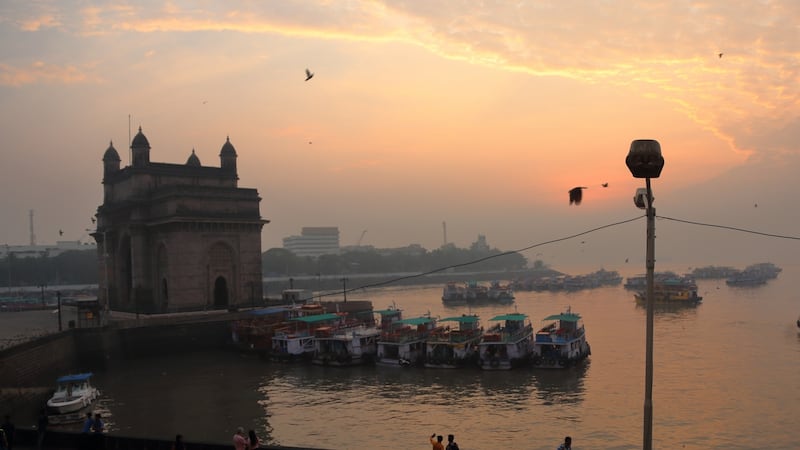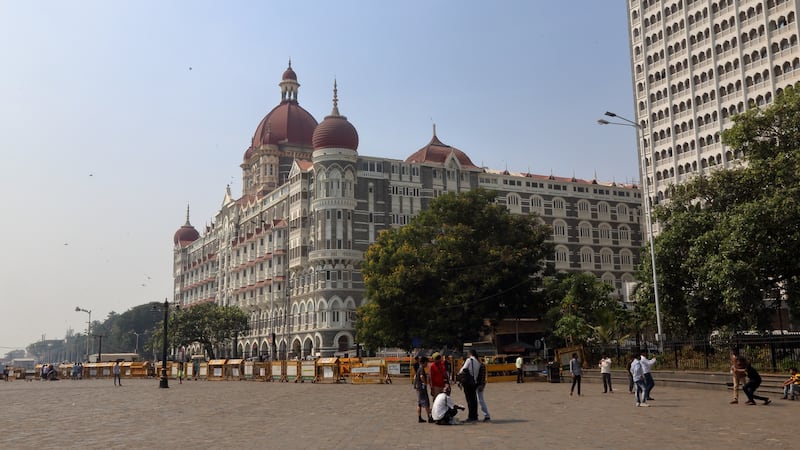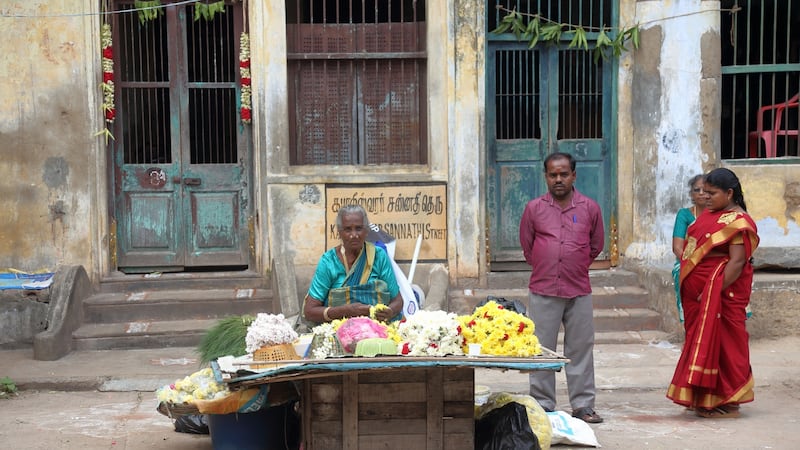It was a shoulder tap so gentle that my startled reaction was a tad excessive. I was lost in the camera viewfinder, trying to grab the perfect shot of the Gateway of India, the sun just so behind the colossal basalt arch, a crowd of equally snap-happy tourists in the foreground.
I turned around, and a man smiled and pointed at who I assumed was his wife, patiently waiting with a camera in hand. It’s only then I noticed the rest of his family had taken up a position on either side of me, resdy to be immortalised.
I raised myself to the full extent of my 5ft 7in frame and sucked in my gut – it hardly mattered that I'd never see the photo – and one big touristy smile later and it was done. Nobody had said a word. I got a barely perceptible nod from the man before they all moved on to the next photo op. This was my introduction to Mumbai, a forget-everything-you-know hello after my journey aboard KLM's recently established direct service from Amsterdam to India's biggest city.

In times past, the gateway offered a more ceremonial welcome to viceroys and the officers of empire, who would disembark here after a long journey by sea, greeted by plenty of pomp and the view of the graceful mansions and elegant art deco apartments along Marine Drive. When the arch was unveiled in 1924, it would have been ridiculous to imagine that within 25 years it would witness the last British troops departing India, the tattered remains of imperial ambition trailing behind them. Hubris is ever-present in India.
Near the arch – and a big reason for why it was built there – is Mumbai's most famous landmark, the Taj Mahal Palace Hotel. The story goes that Parsi industrialist JN Tata (founder of the eponymous conglomerate) was so incensed at being refused entry on racial grounds into Watson's, then the city's fanciest hotel, that he ordered the construction of a new hotel to eclipse it.
Today, Watson’s is an abandoned wreck, while the Taj is not just the city’s most luxurious digs, but an icon of independent India. It hardly matters that the story is a myth and the hotel was built at the urging of the then editor of the Times of India, who coaxed Tata into investing in a hotel that was “worthy of Bombay”. Take that, Watson’s: look upon my works, ye mighty, and despair.
Whatever its origin story, the Taj became a symbol of national progress. It was the first hotel in the city to introduce electricity, ceiling fans and an all-day restaurant. It was the first to employ women, and members of the independence movement used to meet here to chart the path to freedom – including Gandhi, who refused to use the newly installed lifts (another national first) in favour of the grand staircase. The hotel was also the site of India’s first ever nightclub, Blow Up, which opened in the late 1960s. When Islamist terrorists wanted to strike a blow against Mumbai in 2008, the hotel was the focal point of their attack.
Roiling tumult of mayhem
Beyond the high security walls and the carefully manicured luxury is the dun-coloured vastness of Mumbai proper, a roiling tumult of mayhem flecked with blue, after the plastic tarps so many Mumbaikers use to roof their rickety homes. This is the Maximum City, at once intimidating and inviting, with a furious energy that makes New York seem like a provincial town in comparison.
But this is also the film and fashion capital of India, a trendsetter city of workers and crorepatis (millionaires) that is constantly on the move. You can rub shoulders with the film and model set in the fancy bars and restaurants of Bandra and Juhu, and if you’re looking to mingle with Mumbai’s craft beer connoisseurs, you’ll find them congregating in the bars of Andheri.

It’s also, surprisingly, one of the great walking cities of the world, and you’ll need to descend into Mumbai’s orchestrated chaos to really appreciate its beauty – and to recognise that the madness has its own brilliant, idiosyncratic method. Visit at rush hour the monumental, Hindu-Gothic fantasy that is Victoria Terminal, the world’s busiest – and perhaps most beautiful – railway station. This is “super dense crush load”’ time, when more than million commuters cram into 1,250 trains (imagine 14 people jammed inside a phone box) that arrive and depart the 18 platforms in a carefully synchronised frenzy. It’s crazy, but somehow, it works.
I only spent a few days in Mumbai. I crammed in as much as I could: cricket on the famous Oval Maidan, where local demi-god Sachin Tendulkar learnt his craft; a dawn tour of the Sassoon Docks, the city’s atmospheric wholesale fishing market; and a visit to the Mahalaxmi Dhobi Ghat, the world’s largest open-air laundry.
I didn’t visit any of the city’s slums, which collectively are home to an astonishing 60 per cent of Mumbai’s 24 million people. Like any large neighbourhood, the slums are a complex organism of community and activity, and despite perceptions to the contrary, are generally safe to visit. This doesn’t necessarily mean you should, even if slum tours are increasingly popular. The more ethical companies guarantee that the lion’s share of your ticket is spent on projects that directly benefit those who live there, which critics say is a weak attempt to justify the impact of so-called “poverty tourism”. Whatever the ethics of this kind of experience, a firm no-no in the slums is photography, which is considered offensive to the point of aggression.
A little respite
For a little respite, I escape Mumbai for the gentler pleasures of Chennai, on India’s southeastern coast. Everything is mellower here, except for the traffic, which is just as manic as everywhere else. But even this hellscape of congestion, potholes and unmarked roads has its own logic, expertly interpreted by locals in cars that don’t have as much as a scratch on them.

In Chennai, I make my way to yet another Taj hotel. If the Mumbai Taj is a florid expression of architectural ambition, the Taj Connemara is a newly restored statement of art deco restraint. Ceiling moulds and plastered walls echo the stepped geometry of a Hindu temple, but otherwise everything else is art deco cool.
The hotel is named after Galway-born Robert Bourke (1827-1902), the first Baron Connemara and the then governor of Madras. But even this story is disputed, with other sources suggesting it was named after the baron's wife, Lady Connemara, who sought refuge here after leaving her husband on account of his infidelities. To add injury after insult, she had to seek treatment for a venereal disease transmitted by her roguish husband, the ignominy of which led the hotel owner to name the hotel after her rather than Bourke, who resigned his office in disgrace.
Chennai’s soporific charms are pleasant enough, and a wonderful antidote to the frenzied energy of Mumbai. After a couple of days of recharging my batteries and eating delicious south Indian cuisine, however, I found myself yearning to be back by the water in Mumbai, watching the harbour lights flickering to life as the warm breeze comes in off the Arabian Sea, the perfect prelude to another night in the madness of the Maximum City.
Getting
there
KLM (klm.com) flies to Mumbai via Amsterdam four times weekly; return economy fares start at €362 including taxes and charges, with business class fares from €1,656. Jet Airways (jetairways.com) has multiple daily flights between Mumbai and Chennai starting at €63 each way.
Palace wing rooms in the Taj Mahal Palace Mumbai start at €245; colonial rooms in the Taj Connemara Chennai start at €233. See tajhotels.com.
The "Mumbai by Dawn' tour with No Footprints (nfpexplore.com) costs €100.


















